Quiet, Please! An Interactive Workshop for Environmental Health and Planning Professions on Transportation Noise, Its Health Impacts, and Mitigation Strategies
By Hugh W. Davies, PhD, MSc, BSc, CIH
Associate Professor, Occupational and Environmental Health Division
School of Population and Public Health
University of British Columbia
Vancouver, Canada
Introduction
As with many cities in North America, environmental noise in the Metro Vancouver region is regulated at the municipal level. Noise bylaws target high-decibel point sources such as construction sites, leaf blowers, and neighbour noise, such as barking dogs, motorcycles, and loud parties. They are almost entirely based on community response (annoyance). There is growing awareness among public health professionals and citizens of the health effects of noise, however, and there has been increasing interest in the region to review noise policies to ensure they reflect the current understanding of health effects of noise.
While point sources such as those mentioned earlier are sources of annoyance and contribute to localized noise exposure, the largest body of epidemiological evidence is related to noise from transportation sources—from road, aircraft, and trains. Links have been made between transportation noise and various health outcomes, including stress, sleep disturbance, cardiovascular disease, and cognitive effects in children. Unlike in the European Union, where environmental noise has been recognized as a significant public health problem, and investment has been made in better characterizing exposure, educating the public, and reducing noise exposure, few, if any, such health-based policies have been developed in North America, including Canada.
Recognizing this evidence-policy gap, the Environmental Health group at Vancouver Coastal Health partnered with the University of British Columbia’s School of Population and Public Health to develop an educational workshop on noise and health. An invited audience comprising over 70 city planners, transportation planners, environmental health officers, and others involved in designing and maintaining a healthy urban environment gathered on November 25, 2019, for the event.
The objective was to see if we could “move the dial” on the environmental noise hazard in the Greater Vancouver Region, with an initial focus on transportation noise. The event was designed not only to share expert knowledge but also to give a forum for discussion on both problem identification and solution strategies, to begin to map out a pathway forward for municipalities and for the province.
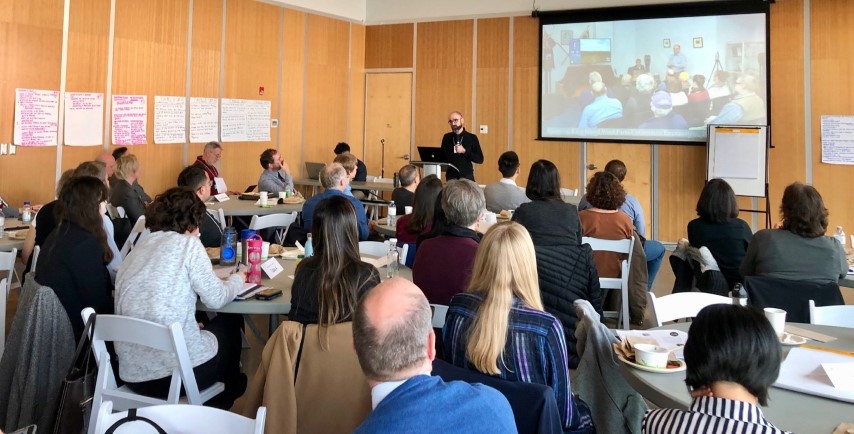
The one-day workshop was opened by Dr. Patricia Daly, vice president, public health, and chief medical health officer for Vancouver Coastal Health, and chaired by Professor Michael Brauer. Professor Brauer is a world-renowned exposure scientist whose research focuses on linkages between the built environment and human health, with specific interest in the relationships between multiple exposures mediated by urban form and population health. He reminded the audience that during his career, air pollution had gone from meetings such as the workshop to where we are today and that there are lessons to be learned from air pollution and opportunities for co-benefits between the two efforts.
Sharing Knowledge
The audience heard from five experts, who spoke to local exposure research, the health effects of noise, policy efforts elsewhere in the world, and approaches to mitigation. Professor Hugh Davies, PhD (University of British Columbia; UBC), described a program of research out of UBC that included the creation of the largest “noise map” in North America (see fig. 2) and the use of the map in a series of health studies among adult and birth cohorts in the Metro Vancouver region; these studies are all published in the peer-reviewed literature and summarized recently in Canadian Acoustics.[1]
Dr. Bryony Croft, PhD (SLR Consulting), gave a review of a recently completed acoustical study of the Vancouver light-rail (Skytrain) system. The Skytrain system has substantially altered development patterns in Vancouver, with greater densification close to light-rail stations. The study of 32 locations and 2,000 train pass-bys showed that maximum pass-by noise levels were considerably above the identified 75 dBA goal at some locations and could reach above 90 dBA. Noise from Skytrain affecting any single location was variable over time, depending on track condition and maintenance cycles, and though there are options to mitigate noise, they are not cheap, nor easy or fast.
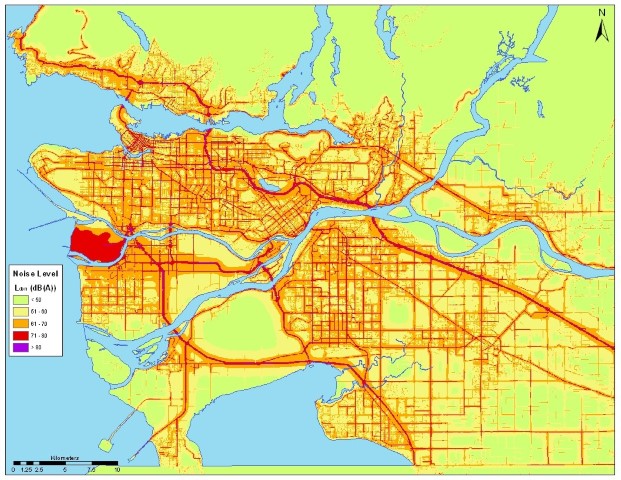
Dr. Mathias Basner, MD, PhD (University of Pennsylvania), described the current state of knowledge regarding noise and health, particularly the effect on sleep and changes in sleep structure, the effects on the cardiovascular system, the risk to vulnerable groups, and the burden of noise-related chronic disease.
Dr. Eoin King, PhD (University of Hartford), reviewed the European experience, the EU Noise Directive as a cyclical process, and advances such as CNOSSUS-EU. He discussed the planning objectives (protect health and well-being, improve quality of life, structure and prioritize noise abatement efforts, involve general public) as well as the challenges faced (such as different calculation methods, discrepancies in state’s reporting numbers, and the lack of requirement to implement), and benefits accrued (such as significant research gains; data created on costs, health; and the focusing of local authorities’ attention). Dr. King also reviewed several mitigation studies, including vehicle bans, geo-fencing of buses, noise barriers, and building soundscapes.
Finally, Joseph Digerness, an acoustical engineer with the Arup Group in New York, challenged the audience to think outside the box both in terms of what our future cities will sound like (with air taxis like Uber Elevate on the horizon) and with respect to controlling noise. “Yet another Noise Barrier?” was the title of his talk. He cautioned that we must consider our soundscapes and the need to preserve the often unique “sonic signature” of our spaces. He also emphasized the importance of public engagement and use of new tools such as auralization.
Group Discussions
Following the expert talks, attendees broke into small groups and considered a number of topics for discussion, including “What are Vancouver’s regional noise problems?,” “What are we doing well with respect to the noise problem, and what are we doing poorly?,” and “What noise mitigation strategies/methods may be appropriate for Vancouver?” Responses were summarized for attendees in a workshop report.
Some of the discussions were more generalizable perhaps to a broader audience and are summarized here. For example, figure 3 shows the discussion points arising from the question “What are the information gaps with respect to noise in Vancouver?” Interestingly, attendees felt that there was a lack of data on exposure and health and also a lack of understanding where responsibilities lie. It was telling, perhaps, that despite invitations, not all levels of government chose to participate in the workshop. Figure 4 summarizes responses for the question “What are your recommendations for next steps in reducing potential harm from noise in Metro Vancouver?” This discussion was interesting for quickly and insightfully revealing the complexity of the problem at hand. Figure 5 illustrates some of the broader issues that came to light and interested participants.
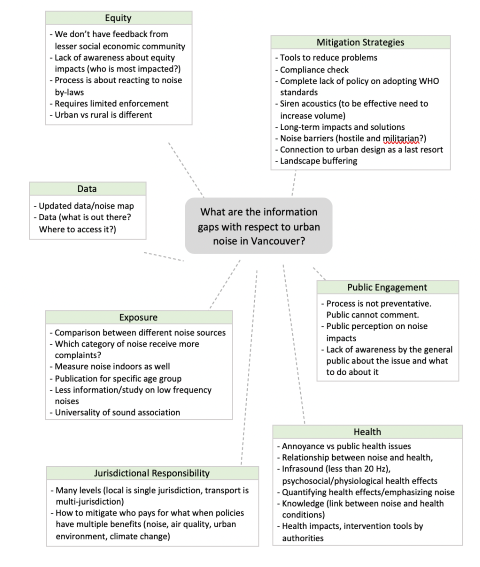
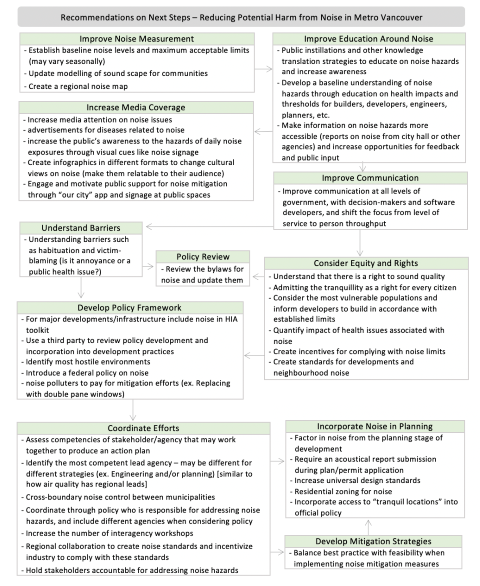
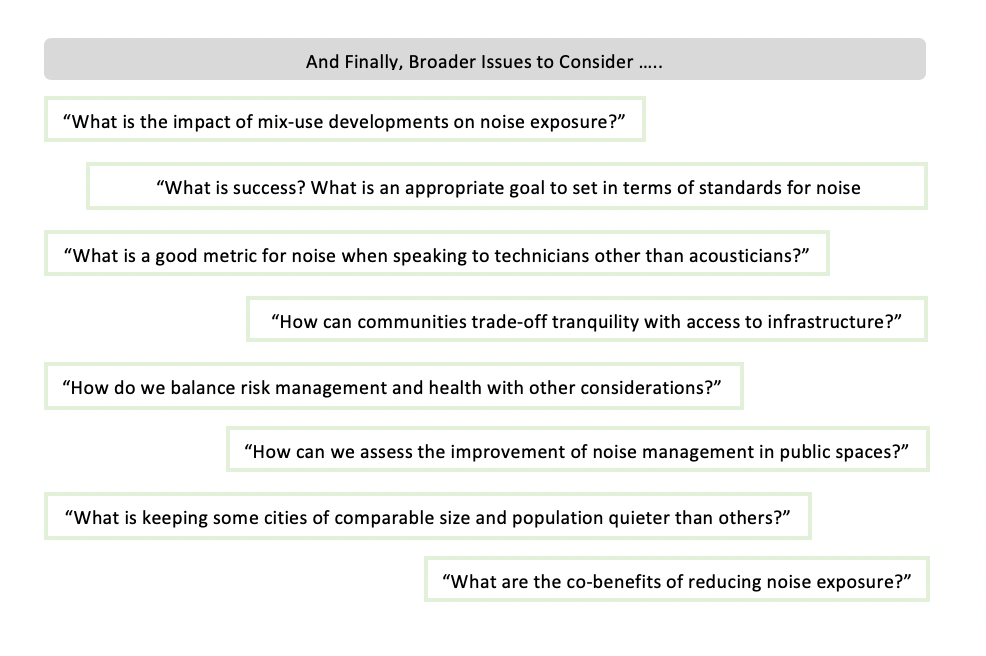
Conclusion
The workshop concluded with a discussion about next steps, and it was decided to continue to offer additional workshops for different target audiences and to enable discussion of efforts and achievements in different regions (Metro Vancouver comprises more than 20 distinct municipalities). The attendees also identified 15 current or upcoming projects and initiatives (ranging from construction to long-term transport planning) where the handling of the impact of noise effects should be reviewed, offering opportunities for immediate impact. Overall the workshop was considered a success by both attendees (over 90 percent rated it excellent or very good) and organizers. The documents and resources used and generated in the workshop are available at a wiki site.
[1] Davies H. W., “Toward a Better Understanding of the Role of Transportation Noise in Chronic Disease: The Vancouver Studies,” Canadian Acoustics 47, no. 4 (Dec 2019).


